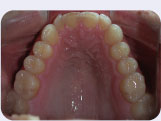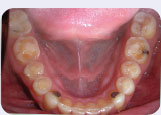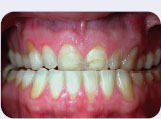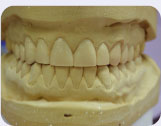
Management of worn dentition I—resulting from dental malocclusion
Accurate diagnosis of a malocclusion is essential in determining the proper treatment approach and timing of treatment. The presented case shows the combined effects of malocclusion with tooth wear. In this chapter, the effects of class III malocclusion, etiology of tooth wear, and treatment approaches are discussed.
CASE STORY
A 45-year-old male patient presents with a chief complaint of “I need to fix my front teeth.” The patient is very concerned with his broken restorations, which had been placed about 1 year ago.
Figure 1: Postoperative maxilla.

Figure 2: Postoperative mandible.

Figure 3: Postoperative presentation.

Figure 4: Diagnostic wax – up.

LEARNING GOALS AND OBJECTIVES
- Understand the etiology of tooth wear.
- Understand the different types of wear patterns.
- I dentify the clinical criteria for pseudo-class III malocclusion.
- Understand the factors considered in selection of restorative materials for patients exhibiting tooth wear.
- Recognize the advantages of a canine-guided occlusal scheme.
Medical History
- No significant findings
Dental History
- I n the past years, the tooth wear had frequently been treated with resin and veneer restorations.
- These restorations were failing, and the patient was seeking more long-term treatment options for functional and aesthetic concerns.
Clinical Findings/Problem List
- Fractured restoration on maxillary right and left central incisors and maxillary left lateral incisor (8, 9, and 10)
- Wear facets on occlusal surfaces of mandibular posterior teeth
- I nterview of patient regarding the dietary pattern revealed high frequency of soft drink intake
- Maxillary and mandibular midlines are not coincident
Diagnosis
- Pseudo-class III malocclusion
- Defective restorations on maxillary anterior teeth
- Tooth wear, possibly due to occlusal trauma in the maxillary anterior region
- Mandibular posterior tooth wear due to erosion
- Loss of vertical dimension of occlusion by 2 mm
Clinical Decision-Making Determining Factors
- The characteristics of class III malocclusion can be separated into
- Skeletal components with a combination of an underdeveloped maxilla and an overdeveloped mandible
- Dentoalveolar components with proclined maxillary incisors
- Retroclined mandibular incisors to achieve dentoalveolar compensation
- The detection of the cause of the discrepancy is essential in developing appropriate treatment (Ngan, Hu et al. 1997; Rabie and Gu 2000).
- Although the dentoskeletal characteristics for pseudo-class III malocclusion are not clearly defined, pseudo-class III malocclusion has been identified with anterior reverse articulation as a result of mandibular displacement. The interference seen in the incisors in pseudo-class III malocclusion is thought to be a result of the retroclined maxillary incisors and proclined mandibular incisors as compared to a true skeletal discrepancy in a class III malocclusion (Lee 1978).
- The treatment of the patient with a class III malocclusion depends on the age at which the patient presents for treatment. Poor aesthetics is often the main reason for seeking treatment (Moss 1976).
- “Tooth surface loss” or “tooth wear” refers to the pathological loss of tooth tissue by a disease process other than dental caries. Tooth wear can be categorized into attrition, erosion, and abrasion:
- Attrition is defined as the loss of enamel, dentin, or restoration by tooth-to-tooth contact.
- Erosion is the loss of dental hard tissues by chemical action not involving bacteria. Eating disorders, such as anorexia and bulimia nervosa, or acid reflux and regurgitation are associated with erosion. Dietary components, such as carbonated soft drinks, fruit, and fruit juices, can also be the causes of erosion, especially related to the increased frequency of intake.
- Abrasion is the loss of tooth structure from factors other than tooth contact (Eccles 1982; Bartlett, Evans et al. 1996; Litonjua, Bush et al. 2004).
- If attrition is the only cause of tooth wear, the wear facets will appear shiny and flat sharp-edged, and produce a similar amount of wear on the opposing teeth (Spear 2008).
- Chemical erosion in which posterior tooth surface loss is greatest at the mandibular first molar and second premolar areas has been associated with holding carbonated soft drinks in the mouth and/or swishing (Verrett 2001).
- Determination of the etiology of chemical wear should involve identification of the wear pattern (Verrett 2001):
- Greater anterior tooth wear, as compared to posterior tooth wear, on the lingual surfaces is associated with chronic regurgitation, eating disorder, gastric acid reflux, and chronic alcoholism.
- Greater anterior tooth wear, as compared to posterior tooth wear, on the facial surfaces of maxillary anterior teeth is related to fruit sucking.
- Greater posterior tooth wear, as compared to anterior tooth wear, on all occlusal surfaces is associated with soda swishing and fruit mauling.
- Selection of an occlusal scheme for fixed restorations is based on the principles of mutually protected occlusion and anterior guidance. Many studies demonstrated that muscle acti/>
Stay updated, free dental videos. Join our Telegram channel

VIDEdental - Online dental courses


